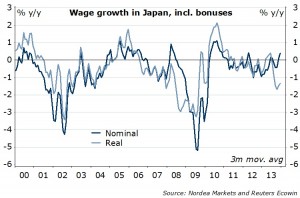Preliminary data showed that the Japanese economy expanded by an annualised 1% in Q4, the lowest in a year. It came as a major downside surprise to the market, which expected 2.8%. The economy grew by 1.6% in 2013 compared to 2012, lower than our projection of 1.8%. Despite the disappointing news Japanese equities rallied and the JPY strengthened vs. the USD to 101.7 at the time of writing.
Just like in Q3, net exports were the largest drag and pulled down growth by 2.2% points. Between October and December Japan posted a trade deficit of JPY 3.5 trillion, creating a new record. Although the weaker yen has helped lifting export growth, imports have become more expensive. For a country as reliant on imported energy as Japan, where energy accounts for 75% of total imports, the trade balance is likely to remain under pressure for the coming quarters. This is particularly true as there are still many obstacles to be overcome before Japan can come out of the nuclear-free period.
Even though private consumption contributed a positive 1.2% points to growth in Q4, there is no reason to cheer for future outlook. In recent months inflation has outpaced nominal wage growth, leading to a decline in real wages. Although large corporations have agreed to hike base salary, they only employ about 30% of the workforce. The small and medium-sized enterprises have not yet gained from Abenomics and have no incentive to raise pay. Consumer confidence is likely to remain at a low level. On top of that, the consumption tax hike in April may cause a plunge in household spending in Q2.
Overall investment pushed up growth by 1.7% points, but it was exclusively public investment. We remain our cautious stance on public investment driven growth, because Japan already has a well-developed infrastructure system. It has the world’s fifth longest network of roads, 680,000 bridges, 10,000 tunnels, 250 bullet trains and 98 airports. Therefore, further improvement may become useless “white elephants”.
On a longer horizon we have not changed our cautious view on the Japanese economy. We maintain the view that monetary and fiscal policy can only play a limited role, and the most crucial step in Abenomics is structural reform. Unfortunately, we have seen no sign of radical changes. For this reason, we keep our forecasts unchanged, that is, GDP growth at 1% in 2015 and JPY at 110 by the end of 2015.
Nordea





